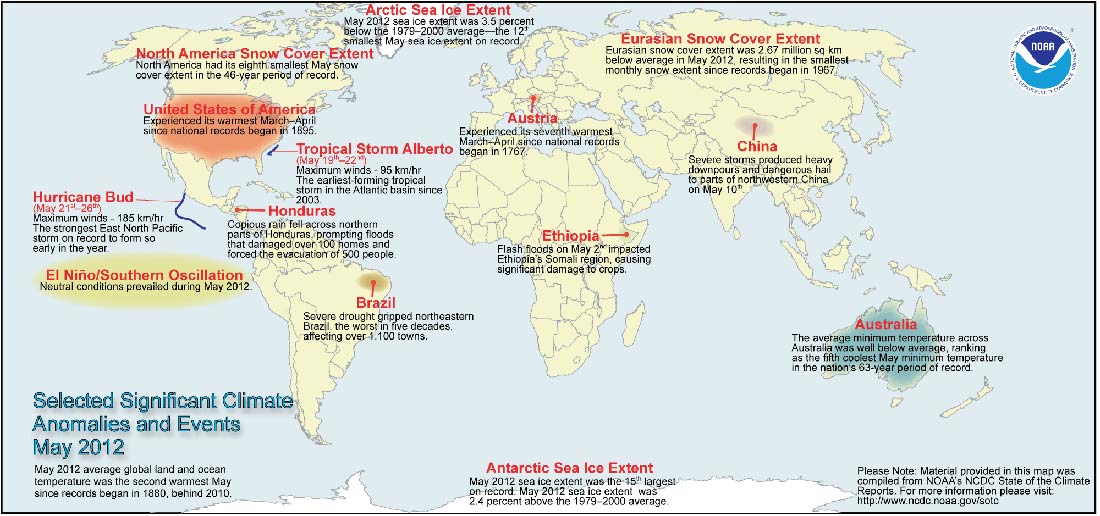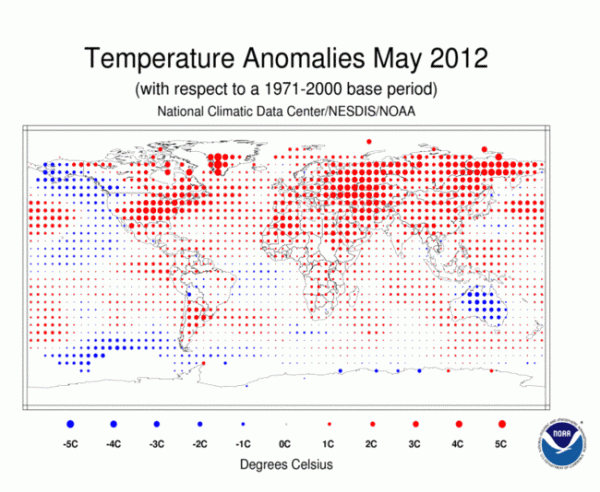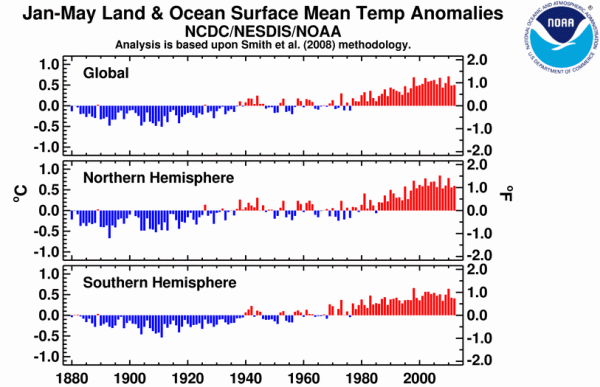
Click here to expand image above
Astronomical summer for the Northern Hemisphere begins tomorrow according to U.S. clocks. The June solstice takes place at 23:09 UTC (6:09 p.m. CDT in the U.S.) on June 20. Meanwhile, NOAA and the National Climatic Data Center (NCDC) have released the monthly temperature stats for May 2012. They say that, globally, the combined land-and-ocean average surface temperature last month made May 2012 the second-warmest May since record-keeping began in 1880.
Everything you need to know: June solstice 2012
Get temperature details in the State of the Climate Global Analysis from NOAA and NCDC
The average global land and ocean surface temperature for May is 14.8 degrees Celsius (58.6 degrees Fahrenheit). May 2012 was 0.66°C (1.19°F) above this average.
In the Northern Hemisphere, land-and-ocean temperatures gave us the warmest May ever recorded, at 0.85°C (1.53°F) above average.
Meanwhile, some parts of the globe experienced cooler-than-average weather in May 2012 including Australia, the state of Alaska, and the Pacific Northwest of North America.

In the image above, you will see a bunch of red and blue dots. The term temperature anomaly means a departure from a reference value or long-term average. In this case, it is a long-term value of temperatures based on the time period from 1970 through 2000. A positive anomaly, which is shown in red, indicates that the observed temperature was warmer than the reference value. A negative anomaly, which is shown in blue, indicates that the observed temperature was cooler than the reference value. It provides us an understanding of exactly how warm or cold a certain time period was based on climatology records.

While we in the Northern Hemisphere experienced our warmest May in the 133-year period of record this year, the Southern Hemisphere’s month of May 2012 was ranked only ninth warmest at 0.47°C (0.85°F) above average. Of course, the Southern Hemisphere is pushing into its winter months, so temperatures there are generally cooling off.
March-May 2012:

It was a warm Northern Hemisphere spring, overall. The March–May period ranked as the seventh-warmest on record for the seasonally-averaged global land-and-ocean temperatures. The Northern Hemisphere spring ranked as the fourth-warmest such period on record, while the Southern Hemisphere autumn was 14th warmest since records began in 1880. For the entire globe, the average land temperature was the fourth-warmest March–May on record, at 1.12°C (2.02°F) above average. Austria reported its seventh warmest spring since records began in 1767. For March-May, the average temperature across the United States was 57.1 degrees Fahrenheit, which was 5.2 degrees above the long term average, making spring 2012 officially the warmest spring ever recorded since records began in 1895.
For Australia, the maximum (daytime) temperatures 0.37°C (0.67°F) below average and minimum (nighttime) temperatures ranking as the fourth lowest on record (-0.93°C / -1.67°F). According to NOAA, autumn nighttime temperatures were the coolest since 1995 in South Australia and coolest since 2000 in Western Australia. La Niña, which tends to have a cooling influence over the country, ended during the season.
January through May 2012

Generally, the global temperatures across land and ocean for the first five months of 2012 is ranked 11th warmest on record for the January through May time period. Since La Niña is fading, surface and ocean temperatures have been gradually increasing as we entered June. The most significant warming was observed over southern Greenland, northern Russia, and the eastern two-thirds of North America. Meanwhile, the coldest temperatures for this time period occurred across nearly all of Alaska, Mongolia and bordering regions, and most of Australia.
Bottom line: Globally, the combined land-and-ocean average surface temperature made May 2012 the second-warmest May since record keeping began in 1880. In the Northern Hemisphere, global land and ocean temperatures gave us the all-time warmest May on record, with temperatures 0.85°C (1.53°F) above the average. The United States has experienced the most extreme warmth across the planet as spring 2012 became officially the warmest spring ever recorded since records began in 1895. Meanwhile, cooler temperatures were felt across Australia, the state of Alaska and across the Pacific Northwest.











